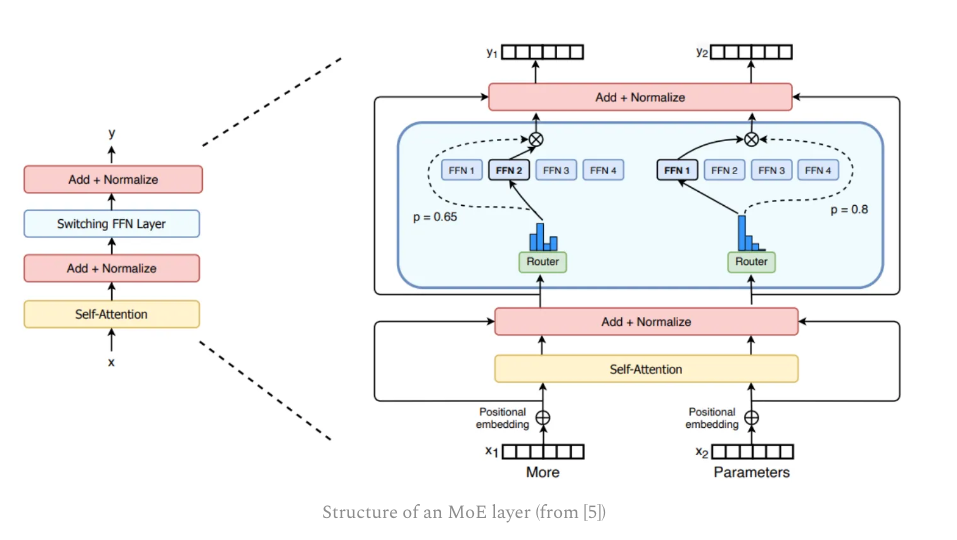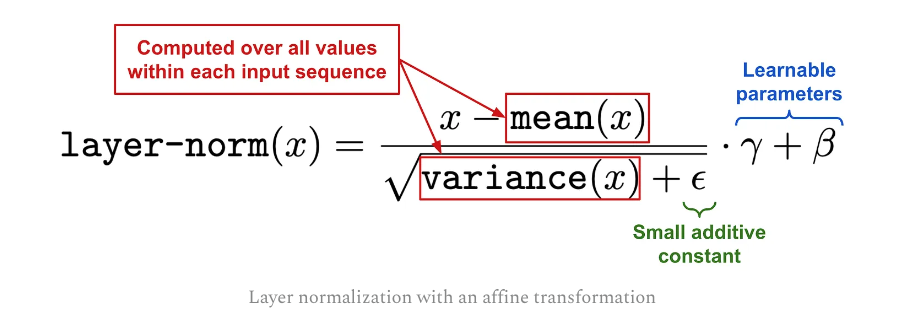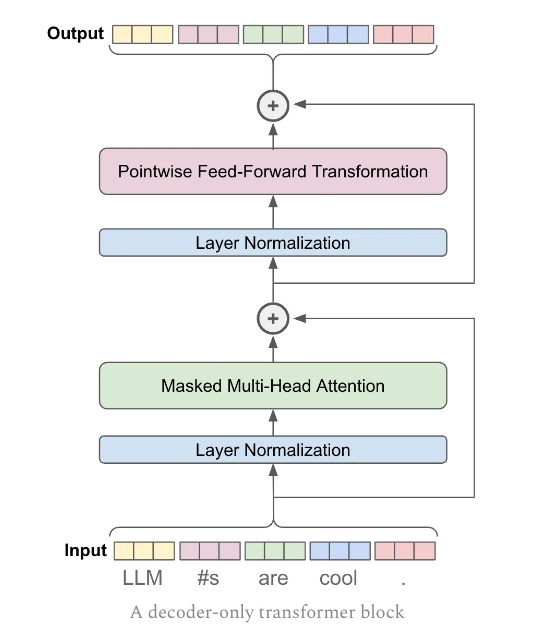MoE and Decoder-Only Transformer code
Summary from this MoE link and this Decoder-only transformer link
1 MoE
In the context of LLMs, MoEs make a simple modification to this architecture: we replace the feed-forward sub-layer with an MoE layer!

Two primary components:
-
Sparse MoE Layer: replaces dense feed-forward layers in the transformer with a sparse layer of several, similarly-structured “experts”.
-
Router: determines which tokens in the MoE layer are sent to which experts.
We impose sparsity by only sending a token to its top-K experts. For example, many models set k=1 or k=2, meaning that each token is processed by either one or two experts, respectively.
2 Mixtral-8x7B MoE
7B Mistral-7B LLM, replace each of its FFSL with MoE layer with EIGHT experts, where TWO experts are activated for each token.
In total, 47B parameters
Inference cost, 14B parameters.
3 Attention block
Batch size: $B$
Sequence length: $T$
token vector dimension: $d$
Num of head: $H$
- Set up Q/K/V matrix
```python
3x dim b/c it includes q/k/v
self.c_attn = nn.Linear(d, 3*d, bias=bias)
split the output into separate query, key, and value tensors
q, k, v = self.c_attn(x).split(self.d, dim=2) # [B, T, d]
reshape tensor into sequences of smaller token vectors for each head
k = k.view(B, T, self.H, self.d // self.H).transpose(1, 2) # [B, H, T, d // H] q = q.view(B, T, self.H, self.d // self.H).transpose(1, 2) v = v.view(B, T, self.H, self.d // self.H).transpose(1, 2)
- Compute the attention matrix, perform masking and apply dropout
```python
# [B,H,T,d//H] @ [B,H,d//H,T] ->[B,H,T,T]
# k.size(-1) -> d//H
att = (q @ k.transpose(-2, -1)) * (1.0 / math.sqrt(k.size(-1))) # [B, H, T, T]
# Apply masking
att = att.masked_fill(self.bias[:,:,:T,:T] == 0, float('-inf'))
att = F.softmax(att, dim=-1)
att = self.attn_dropout(att)
- Compute output vectors
```python
[B,H,T,T]@[B,H,T,d//H]
y = att @ v # [B, H, T, d // H]
concatenate outputs from each attention head and linearly project
y = y.transpose(1, 2).contiguous().view(B, T, self.d) # [B,T,d]
self.c_proj = nn.Linear(d, d, bias=bias)
y = self.resid_dropout(self.c_proj(y))
## 4 Normalization, Feed-Forward and Residual connect
Different type of normalization, it's all about which mean and standard deviation to use.
```python
for i in range(nlayers):
# The normalization
output = (output - torch.mean(output)) / torch.std(output)
# # For each NN layer, multiply the vector by the matrix
output = weight_matrix @ output
The layer-norm is modified with an affine transformation as below
 THe point-wise Feed-Forward network is defined as below
THe point-wise Feed-Forward network is defined as below
def forward(self, x):
#self.c_fc = nn.Linear(d, 4 * d, bias=bias)
x = self.c_fc(x) # [B, T, 4*d]
#self.gelu = nn.GELU()
x = self.gelu(x)
#self.c_proj = nn.Linear(4 * d, d, bias=bias)
x = self.c_proj(x) # [B, T, d]
#self.dropout = nn.Dropout(dropout)
x = self.dropout(x)
return x
The Resi-Net code is straightfoward
def forward(self, x):
#self.ln_1 = nn.LayerNorm(d)
#self.attn is the attention block
x = x + self.attn(self.ln_1(x))
#self.ln_2 = nn.LayerNorm(d)
#self.ffnn is the feed-forward NN
x = x + self.ffnn(self.ln_2(x))
return x
Now we complete following figure for decoder block.

5 Adding Embedding layers
- The token embedding layer is just a mtrix with size [V, d], where V is the size of the tokenizers’ vocabulary. We can simply lookup the token’s embedding from the matrix. It’s impleted by Torch simple lookup table API
nn.Embedding(num_embeddings, embedding_dim)# wte=nn.Embedding(V, d), # token embeddings # idx.size() == [B, T] # For each idx, will generate a size-d vector tok_emb = self.transformer.wte(idx) # [B, T, d] - The position embedding layers.
# wpe=nn.Embedding(T, d), # position embeddings # pos = torch.arange(0, T, dtype=torch.long, device=device) # [T] # For each pos, will generate a size-d vector pos_emb = self.transformer.wpe(pos) # [T, d]
The input is the summation of these two ` x = self.transformer.drop(tok_emb + pos_emb) ` and the training or inference code is as below
# pass through all decoder-only blocks
for block in self.transformer.blocks:
x = block(x)
x = self.transformer.ln_f(x) # final layer norm
if targets is not None:
# compute the loss if we are given targets
# head=nn.Linear(d, V, bias=bias)
logits = self.transformer.head(x)
loss = F.cross_entropy(
logits.view(-1, logits.size(-1)),
targets.view(-1),
ignore_index=-1,
)
else:
# only look at last token if performing inference
logits = self.transformer.head(x[:, [-1], :])
loss = None
return logits, loss
Here is the whole picture now
